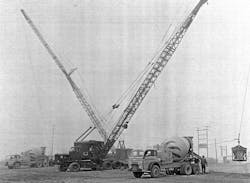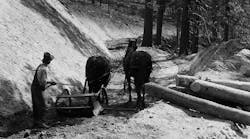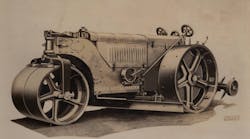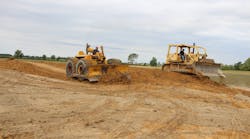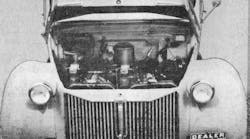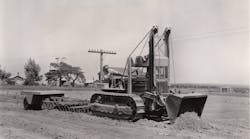The idea for a truck-mounted crane originated with the American Expeditionary Forces in World War I. A need had arisen for a mobile crane for dockside use, and although that need was addressed by cranes on steel traction wheels produced by Thew Shovel Co., Thew president Frank A. Smythe was intrigued by the potential of a truck-mounted crane. The first such machine was built in 1918. These cranes were assembled by mounting an upper works on a commercial truck furnished by the customer, a practice that continues today for many truck-mounted cranes.
Larger cranes, of course, required heavier trucks, and purpose-built crane carriers were introduced in the late 1930s. These carriers usually were of a half-cab, cab-over-engine design, with the top of the windshield often angled back to allow upward visibility from the driver’s seat. But the carriers were typically produced by an outside company. Thew, for instance, advertised that every carrier in its Lorain Moto-Crane truck crane line had received a road test of some 70 miles—the distance, coincidentally, between the Ohio Locomotive Crane Co. factory in Plymouth, Ohio, where the carriers were built, and the Thew plant in Lorain, Ohio.
While most of the purpose-built carriers looked pretty much alike, there were occasional exceptions. The photo that appears with this article illustrates such a case. The crane appears to be an early Manitowoc product, but the carrier it sits on is unlike any other this author has seen. It’s believed to be an early Kenworth truck, and the long hood and the dual front tires are highly unusual for this application.
Quite unusual, too, is the way this crane and the one behind it (apparently a Lorain) are rigged. The Lorain wields an exceptionally long jib, and the rigging at upper right and the angle of the hoist cable on the Manitowoc suggest that it has a disproportionately long jib as well. The concrete bucket is tied off to a dragline cable rather than the tagline, so it can be hauled in for filling and reeled out to dump.
The location of this photo is unknown, but the Graham Dependable Concrete Service name suggests southern California. The transit mixers are on White 3000 trucks from the late 1940s.
Berry is archivist for the Historical Construction Equipment Association, a 501(c)3 non-profit organization dedicated to preserving the history of the construction, dredging, and surface mining equipment industries. With more than 4,000 members in 25 countries, our activities include publication of a quarterly educational magazine, Equipment Echoes; operation of the National Construction Equipment Museum and archives in Bowling Green, Ohio; and hosting an annual working exhibition of restored construction equipment. Our 2016 Convention is at our Museum, September 16-18, 2016. Individual memberships are $35.00 within the USA and Canada, and $45.00 US elsewhere. We seek to develop relationships in the equipment manufacturing industry, and we offer a college scholarship for engineering and construction management students. Information is available at www.hcea.net, or by calling 419.352.5616 or e-mailing [email protected].
